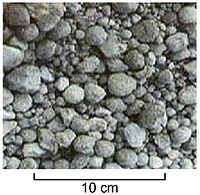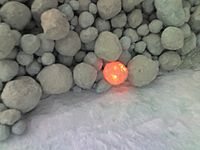- Clinker (cement)
-
In the manufacture of Portland cement, clinker is lumps or nodules, usually 3-25 mm in diameter, produced by sintering limestone and alumino-silicate during the cement kiln stage.
Contents
Uses
Clinker is ground (usually with the addition of a little gypsum, that is, calcium sulfate dihydrate) to become Portland cement. It may also be combined with other active ingredients or chemical admixtures to produce:
Clinker, if stored in dry conditions, can be kept for several months without appreciable loss of quality. Because of this, and because it can easily be handled by ordinary mineral handling equipment, clinker is traded internationally in large quantities. Cement manufacturers purchasing clinker grind it as an addition to their own clinker at their cement plants. Manufacturers also ship clinker to grinding plants in areas where cement-making raw materials are not available.
Clinker grinding aids
Gypsum is added to clinker primarily as an additive preventing the flash settings of cement, but it is also very effective to facilitate the grinding of clinker by preventing agglomeration and coating of the powder at the surface of balls and mill wall.
Organic compounds are also often added as grinding aids to avoid powder agglomeration. Triethanolamine (TEA) is commonly used at 0.1 wt. % and is proved to be very effective. Other additives are sometimes used, such as ethylene glycol, oleic acid, dodecyl-benzene sulfonate, ... . [1]
Portland cement clinker is made by heating in a rotary kiln at high temperature a homogeneous mixture of raw materials. The products of the chemical reaction aggregate together as molten minerals at the sintering temperature. The sintering temperature for modern cements is about 1450 °C. Aluminium oxide and iron oxide are present as a flux and contribute little to the cement strength. For special cements, such as Low Heat (LH) and Sulfate Resistant (SR) types, it is necessary to limit the amount of tricalciumaluminate (3 CaO·Al2O3) formed. The major raw material for the clinker-making is usually limestone (CaCO3) mixed with a second material containing clay as source of alumino-silicate. Normally, an impure limestone which contains clay or SiO2 is used. The CaCO3 content of these limestones can be as low as 80 %. Second raw materials (materials in the rawmix other than limestone) depend on the purity of the limestone. Some of the second raw materials used are: clay, shale, sand, iron ore, bauxite, fly ash and slag.
See also
References
- ^ Sohoni, S.; R. Sridhar, G. Mandal (1991). "Effect of grinding aids on the fine grinding of limestone, quartz and portland cement clinker". Powder Technology 67 (3): 277–286. doi:10.1016/0032-5910(91)80109-V.
Wikimedia Foundation. 2010.


